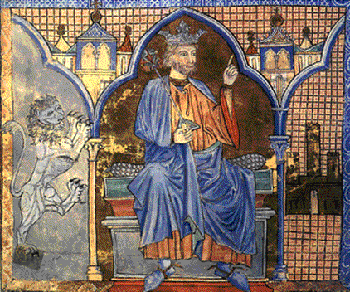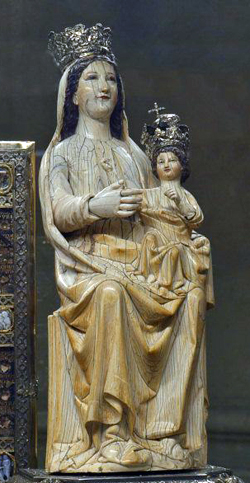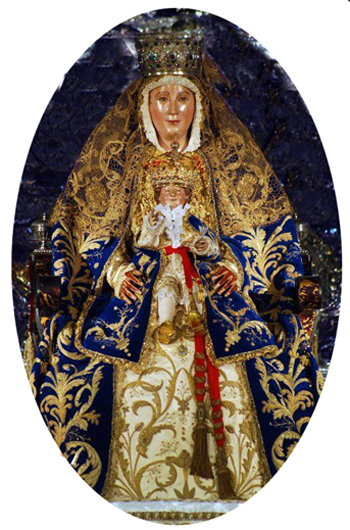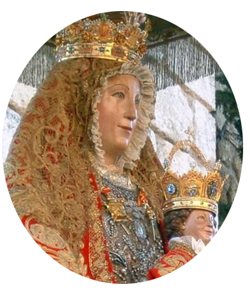Personalities
 |
 |
 |
 |
 |
 |
 |
King Ferdinand III & the Siege of Seville - I
The Origin of The Virgin of the Kings
In the year 1248, King St. Ferdinand III of Leon and Castile was laying siege to the city of Seville, the greatest of the Andalusian cities. It would be the most difficult of the many victories that this monarch - renowned for never losing a battle - made on this earth for Our Lord and Our Lady.
His devotion to the Virgin Mother of God, whom he called 'My Lady,' was most tender, and he carried a small statue of her fixed on his saddle into every battle. In return she procured for him victory in all his battles.
 During his long reign (1216-1252), Ferdinand first united the kingdoms of Castile and Léon, and then ceaselessly made wars against the Moors to free Spain from their yoke. Citadels that had long been governed by the Moors fell, one by one, to the warrior King. A last major city still under Moorish control was Seville, the largest, strongest and most populous city.
During his long reign (1216-1252), Ferdinand first united the kingdoms of Castile and Léon, and then ceaselessly made wars against the Moors to free Spain from their yoke. Citadels that had long been governed by the Moors fell, one by one, to the warrior King. A last major city still under Moorish control was Seville, the largest, strongest and most populous city.
The siege was long and hard. The Catholic army was weak in numbers, the Saracens fought fiercely with the advantage of position within the heavily fortified double wall with 166 towers. The siege began in July of 1247 and seemed as if it would never end. The long months dragged on one after another.
By summer of 1248, the trial passed almost beyond human endurance. Men literally died from the stifling heat and the severe conditions gave the impression that boiling air had been sent up from the very pits of hell.
As if this new affliction were not enough, at the same time a deadly sickness struck Ferdinand’s camp that also began to take the lives of many of his men. One of those who died was Don Gonzalo Ruiz Giron, the King’s chamberlain, personal advisor and close friend. To make matters worse the royal coffers that were financing the campaign were almost empty. All this had a demoralizing effect on Ferdinand's spirit, submerging him into a deep anguish that he had never before experienced.
 He was harassed by doubts and sorrows that oppressed him relentlessly. Had he not seen St. Isidore who had ordered him to make the siege of Seville? What if his vision had been a diabolical deceit and he was needlessly exposing so many trusting people to die in the camp after having suffered so many miseries.
He was harassed by doubts and sorrows that oppressed him relentlessly. Had he not seen St. Isidore who had ordered him to make the siege of Seville? What if his vision had been a diabolical deceit and he was needlessly exposing so many trusting people to die in the camp after having suffered so many miseries.
Ferdinand suffered intensely from these sorrows, but no one - from the nobles of his house to the foot soldiers of the army - recognized by his appearance and conversation the grief he was undergoing. Only Queen Joan, who loved him greatly and had joined him in the camp to lift the morale of his men, suspected how much he was suffering interiorly.
Dona Joan had always known of her husband’s special devotion to the Blessed Virgin Mary, and some interesting information was brought to her attention. Six months before, the King had gone to Alcalá de Guadaira to spend some days in prayer and penance to obtain the end of a drought. Ferdinand had returned in a state of great peace and joy. He also complained several times that men could not produce a true image of Our Lady, especially her sweet and tender smile.
Thus, Joan correctly deduced that her husband had seen her. Knowing that, she thought it would give him great joy to have a lifelike image of the Glorious Virgin.
A surprise gift for the King
The Queen sent a message to Burgos, which the King's brother Don Alfonso governed, requesting that the finest artists in the kingdom be sent to her to create an image of Our Lady more beautiful than any he had ever seen.
After a while, two young artists arrived, stating that they had responded to the summons. Dona Joan found a private room in an old tower for them to work. There they were left, always well guarded from a possible Moslem attack.
They remained in the tower until, when their work was finished, they sent word to the Queen. She went to see it and was very pleased because, as she had urged, the Virgin's face had a remarkably kind and sweet expression. In a state of awe, Dona Joan knelt before the image of the Queen of Heaven, a statue that would soon become known as the Virgin of the Kings.
 The statue needed only a gown. Using a rich, royal material of the most beautiful silk, Dona Joan and her maids sewed the embroidered garments, enriching them with gold threads and precious stones. Meanwhile, goldsmiths in Toledo prepared exquisite golden crowns for the Blessed Mother and her Child. The statue was then secretly taken during the night to the chapel while King Fernando completed his turn at the night watch.
The statue needed only a gown. Using a rich, royal material of the most beautiful silk, Dona Joan and her maids sewed the embroidered garments, enriching them with gold threads and precious stones. Meanwhile, goldsmiths in Toledo prepared exquisite golden crowns for the Blessed Mother and her Child. The statue was then secretly taken during the night to the chapel while King Fernando completed his turn at the night watch.
What a surprise for the King the next morning when he arrived to recite Prime with the priests and attend Mass and saw on the altar the precious image! The likeness of the Mother of God was so vivid that throughout the divine liturgy, he was enraptured by the appearance of the Lady he was allowed to contemplate.
The Queen glanced at him out of the corner of her eye and, seeing her husband's joy and devotion, felt well rewarded for her troubles. On his part, the King was no less generous in responding to her kind gesture. When the time came to distribute the conquered property from the sieges, Joan shared in the same rewards as his victorious heroes. Consequently, after the fall of Seville, he gave her the lordship of the town of Carmona.
As we will see in the next episode, Our Lady of the Kings would have a role to play in the conquest of Seville.
To be continued

Adapted from M.C. Fernandez de Castro ACJ,
The Life of the Very Noble King of Castile and Léon, Saint Ferdinand III,
NY: The Foundation for a Christian Civilization, Inc. 1987, pp, 241-245
Posted November 19, 2018
His devotion to the Virgin Mother of God, whom he called 'My Lady,' was most tender, and he carried a small statue of her fixed on his saddle into every battle. In return she procured for him victory in all his battles.

After uniting Castile and Leon, Ferdinand began his constant wars against the Muslims
The siege was long and hard. The Catholic army was weak in numbers, the Saracens fought fiercely with the advantage of position within the heavily fortified double wall with 166 towers. The siege began in July of 1247 and seemed as if it would never end. The long months dragged on one after another.
By summer of 1248, the trial passed almost beyond human endurance. Men literally died from the stifling heat and the severe conditions gave the impression that boiling air had been sent up from the very pits of hell.
As if this new affliction were not enough, at the same time a deadly sickness struck Ferdinand’s camp that also began to take the lives of many of his men. One of those who died was Don Gonzalo Ruiz Giron, the King’s chamberlain, personal advisor and close friend. To make matters worse the royal coffers that were financing the campaign were almost empty. All this had a demoralizing effect on Ferdinand's spirit, submerging him into a deep anguish that he had never before experienced.

The ivory Virgen fixed on the King's saddle entered every combat with him
Ferdinand suffered intensely from these sorrows, but no one - from the nobles of his house to the foot soldiers of the army - recognized by his appearance and conversation the grief he was undergoing. Only Queen Joan, who loved him greatly and had joined him in the camp to lift the morale of his men, suspected how much he was suffering interiorly.
Dona Joan had always known of her husband’s special devotion to the Blessed Virgin Mary, and some interesting information was brought to her attention. Six months before, the King had gone to Alcalá de Guadaira to spend some days in prayer and penance to obtain the end of a drought. Ferdinand had returned in a state of great peace and joy. He also complained several times that men could not produce a true image of Our Lady, especially her sweet and tender smile.
Thus, Joan correctly deduced that her husband had seen her. Knowing that, she thought it would give him great joy to have a lifelike image of the Glorious Virgin.
A surprise gift for the King
The Queen sent a message to Burgos, which the King's brother Don Alfonso governed, requesting that the finest artists in the kingdom be sent to her to create an image of Our Lady more beautiful than any he had ever seen.
After a while, two young artists arrived, stating that they had responded to the summons. Dona Joan found a private room in an old tower for them to work. There they were left, always well guarded from a possible Moslem attack.
They remained in the tower until, when their work was finished, they sent word to the Queen. She went to see it and was very pleased because, as she had urged, the Virgin's face had a remarkably kind and sweet expression. In a state of awe, Dona Joan knelt before the image of the Queen of Heaven, a statue that would soon become known as the Virgin of the Kings.

The Virgen of the Kings with
her sweet and tender smile
What a surprise for the King the next morning when he arrived to recite Prime with the priests and attend Mass and saw on the altar the precious image! The likeness of the Mother of God was so vivid that throughout the divine liturgy, he was enraptured by the appearance of the Lady he was allowed to contemplate.
The Queen glanced at him out of the corner of her eye and, seeing her husband's joy and devotion, felt well rewarded for her troubles. On his part, the King was no less generous in responding to her kind gesture. When the time came to distribute the conquered property from the sieges, Joan shared in the same rewards as his victorious heroes. Consequently, after the fall of Seville, he gave her the lordship of the town of Carmona.
As we will see in the next episode, Our Lady of the Kings would have a role to play in the conquest of Seville.
To be continued


Adapted from M.C. Fernandez de Castro ACJ,
The Life of the Very Noble King of Castile and Léon, Saint Ferdinand III,
NY: The Foundation for a Christian Civilization, Inc. 1987, pp, 241-245
Posted November 19, 2018
______________________
______________________
 Volume I |
 Volume II |
 Volume III |
 Volume IV |
 Volume V |
 Volume VI |
 Volume VII |
 Volume VIII |
 Volume IX |
 Volume X |
 Volume XI |
 Special Edition |


